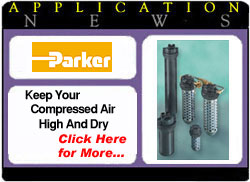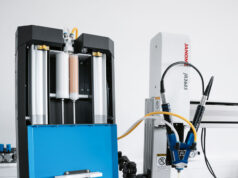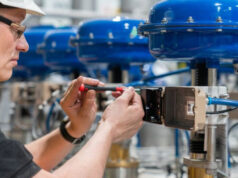 Proper selection and application of air dryers maintains system reliability and longevity.02/21/2007
Proper selection and application of air dryers maintains system reliability and longevity.02/21/2007
By Rick Hand, Parker Hannifin Corp., and Mark White, Domnick Hunter Ltd.
Desiccant dryers remove liquid from compressed air systems through the use of chemical beds.
Most maintenance and production engineers would say that oil is the major contaminant in their compressed air system. Wrong. Nearly all of the total liquid contamination found in a compressed air system is water, with oil being a small part of the overall contamination problem. Filter systems can remove oil and dust, but dryers are required to remove water and adjust humidity.
How much water is actually in your compressed air system? The answer might surprise you. A small 100 cfm compressor and refrigeration dryer combination, operating for 4000 hours in typical northeastern U.S. climate conditions, can produce approximately 2200 gal of liquid condensate per year!
Failing to remove this moisture from a compressed air system can result in condensation in piping, pneumatic tools, and instruments, leading to damage and premature failure.
Water, water, everywhere
Simply put, atmospheric air contains water vapor. The air’s ability to hold water vapor is dependent upon its temperature. As temperature increases, the level of water vapor held by the air increases.
During compression, air temperature is increased significantly, which allows the air to retain incoming moisture. It takes 7.8 ft3 of free air to generate 1 ft3 of compressed air at 100 psig. After the compression stage, air is typically cooled to a usable temperature, reducing the air’s ability to retain water vapor. A proportion of the water vapor condenses into liquid water and is removed by a drain fitted to the compressor after-cooler.
Further condensation occurs as air is cooled by the air receiver, piping, and as it expands in valves, cylinders, tools, and machinery. Condensed water and water aerosols can cause corrosion to the storage and distribution system, as well as damage to production machinery and an application’s end products. Liquid water can also wash away pre-lubricants on the cylinders and valves, decreasing their operational life. Water in a compressed air system also reduces production efficiency and increases maintenance costs.
Benefits from using dryers
Low-pressure dew points derived from implementing air dryers helps prevent corrosion and inhibits the growth of micro-organisms within the compressed air system. Corrosion causes rust and pipe scale that, over time, breaks away and causes damage or blockage in production equipment and, in some cases, can contaminate final product and processes. Moist air provides an ideal environment for the growth of micro-organisms. If only a few of these bacteria or viruses enter a sterile process or clean production system, damage may result, diminishing product quality or rendering a product unfit for use.
A few examples of pneumatic applications that benefit from the use of dryers in the compressed air system, from chemical processing to blow molding, include:
· Paint spraying that requires the removal of water from the air to eliminate blemishes in the painted surface — increasing quality at body shops and large auto plants alike
· Folding and either taping or gluing cardboard boxes — water could affect adhesives and/or damage the boxes
· Semiconductor processes that populate circuit boards would be compromised if moisture reached component contacts
· Chemical or pharmaceutical compound mixing must eliminate moisture to maintain batch integrity
· Automated pharmaceutical dispensing operations must ensure that moisture doesn’t contaminate drugs
· Food industry processes must remove moisture that may contaminate the product
· Blow molding — as varied as making plastic bottles or camera lenses — requires the removal of moisture.
The right dryer for the application
Selecting the right dryer requires a combination of evaluating technical factors with actual field experience. Factors include the type of system, size of connecting lines, water capacity, flow capacity (system size), filtration capability, construction materials (i.e., steel or copper), and safe working pressures.
Two common types of dryers are refrigeration and adsorption (desiccant). When choosing a dryer, a general rule is to first select a pressure dew point that meets the requirements of the application and is 15° to 20° below the plant’s lowest ambient conditions. (A dryer’s efficiency is measured as the dew point, which is the level of dryness in a compressed air system.)
Dew point determines the major difference for selecting either refrigeration dryers or desiccant models. Refrigeration dryers cool air to a pressure dew point of 35° F, which is the effective limit on this type of dryer, as water freezes at 32° F. This style is ideal for general industrial applications in light assembly, including those that use air motors, air tools, valves, cylinders and rotary actuators, and painting and welding equipment. When piping is installed in ambient temperatures below the dryer dew point (i.e., systems with outside piping), refrigeration dryers are not suitable.
Adsorption dryers pass air over a regenerative adsorbent material that strips moisture from the air. These types of dryers are extremely efficient and can provide a pressure dew point as low as -100° F, with a typical range of -40° F. Desiccant dryers remove liquid from the compressed air system through the use of chemical beds. Three styles are commonly used:
· Silica gel: Very good for water vapor removal and produces a dew point of approximately -40° F. Liquid water can damage this style.
· Activated alumina: Very food for water removal and produces a dew point of approximately -40° F. This style provides strong resistance to liquid water.
· Molecular sieve: This material is excellent for water vapor removal and can produce a dew point of -100° F. Liquid water can easily damage this style.
It should be noted that refrigeration and adsorption dryers are designed to remove water vapor, not water in liquid form. They require the use of coalescing filters, installed in front of them in the compressed air system, to work efficiently. In fact, coalescing filters are probably the most important purification equipment in a compressed air system. They are designed to remove aerosols (droplets) of oil and water using mechanical filtration techniques.
Coalescing filters have the additional benefit of removing solid particles as small as 0.01 °m. When filters are installed in pairs, most users believe one is an oil removal filter and the other is a particulate filter. Actually, the filters both perform the same function, with the first filter (a general-purpose filter) used to protect the second filter (a high efficiency filter) from bulk contamination. This dual filter installation ensures a continuous supply of high quality compressed air with low operational costs and minimal maintenance requirements.
Cost-effective system design
To achieve the stringent air quality levels required for today’s production facilities, a careful approach to system design, commissioning, and operation must be employed. Air treatment at one point alone within a system is not enough; a system-wide approach should be taken. Compressed air should be treated prior to entering the distribution system to a quality level suitable for protecting air receivers and distribution piping. The size of piping should be considered as well. Many existing systems have piping that is too small, so it restricts air flow.
Our dryers are not the same
Products for the filtering and drying compressed air are often selected because of their initial lower purchase cost, with little regard for the air quality they provide or the cost of operation and maintenance throughout their life cycle. Dryer equipment with a low purchase price may turn out to be a costly investment in the long run. While initial purchase costs are important, air quality, energy efficiency, and lifetime costs are the real issues.
Poor air quality with too much moisture can damage components in the air system, as well as to end products – costing a manufacturer in terms of both money and reputation. Quality air dryers also minimize pressure loss, a major contributor to operational costs, thus reducing energy consumption. And finally, quality air dryers last longer than lower priced models, reducing downtime and maintenance costs while contributing to increased output.
By improving air quality, lowering energy consumption, and minimizing maintenance, air dryers from leading providers can reduce the total cost of ownership and improve a manufacturer’s bottom line through improved production efficiencies.
Rick Hand is with Parker Hannifin, Pneumatic Div., Richland, Mich., and Mark White is with Parker’s Domnick Hunter Ltd., Tyne and Wear, England. Contact them at rhand@parker.com and mark.white@parker.com









